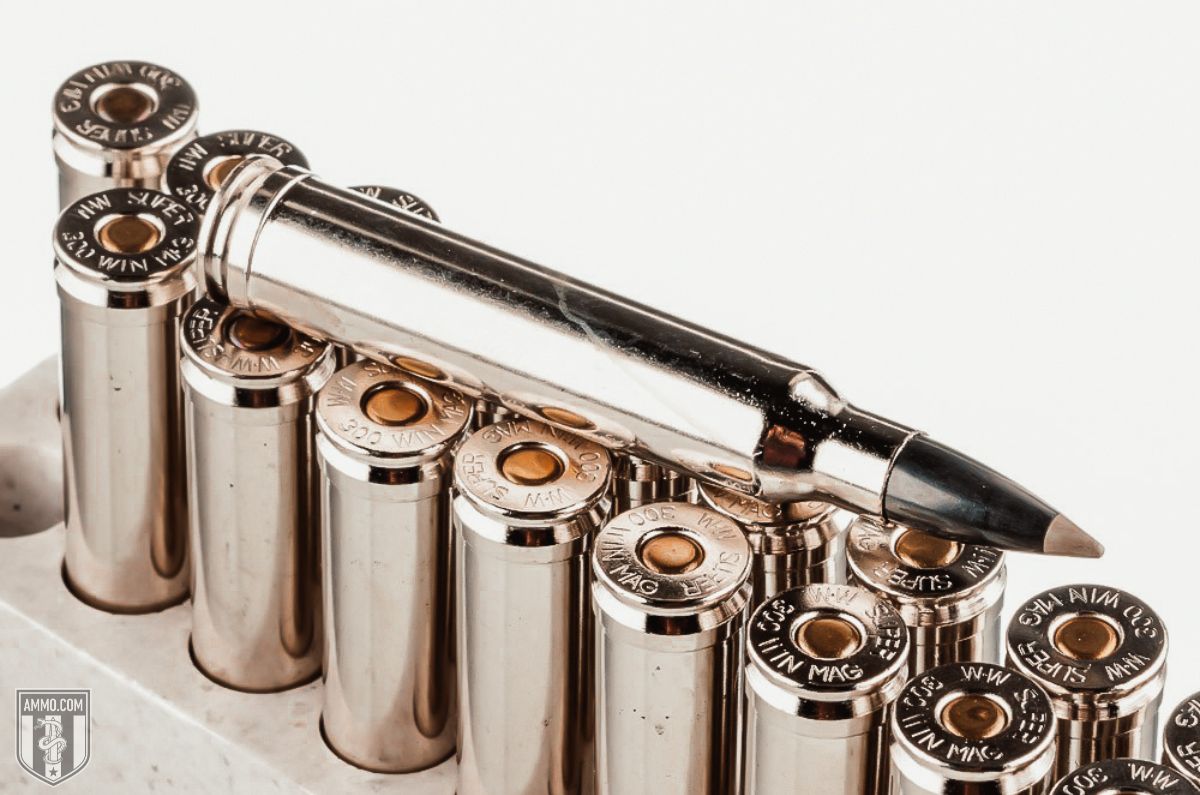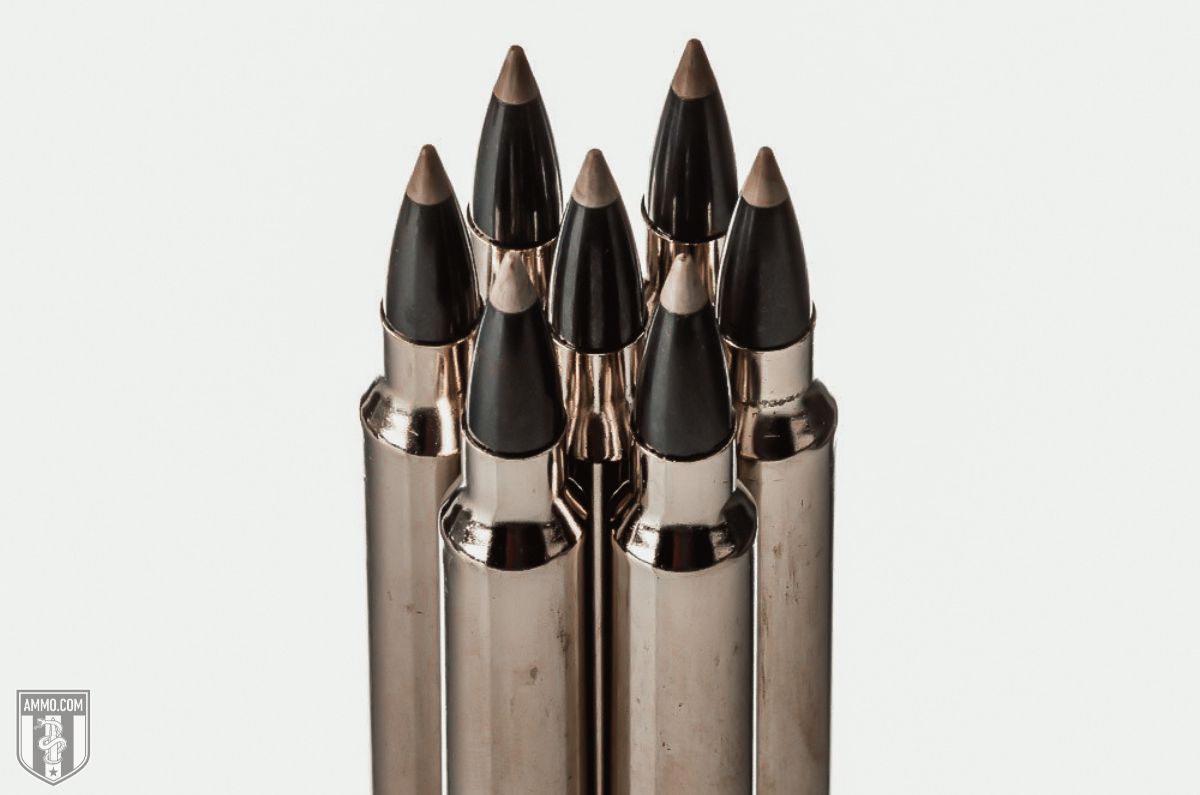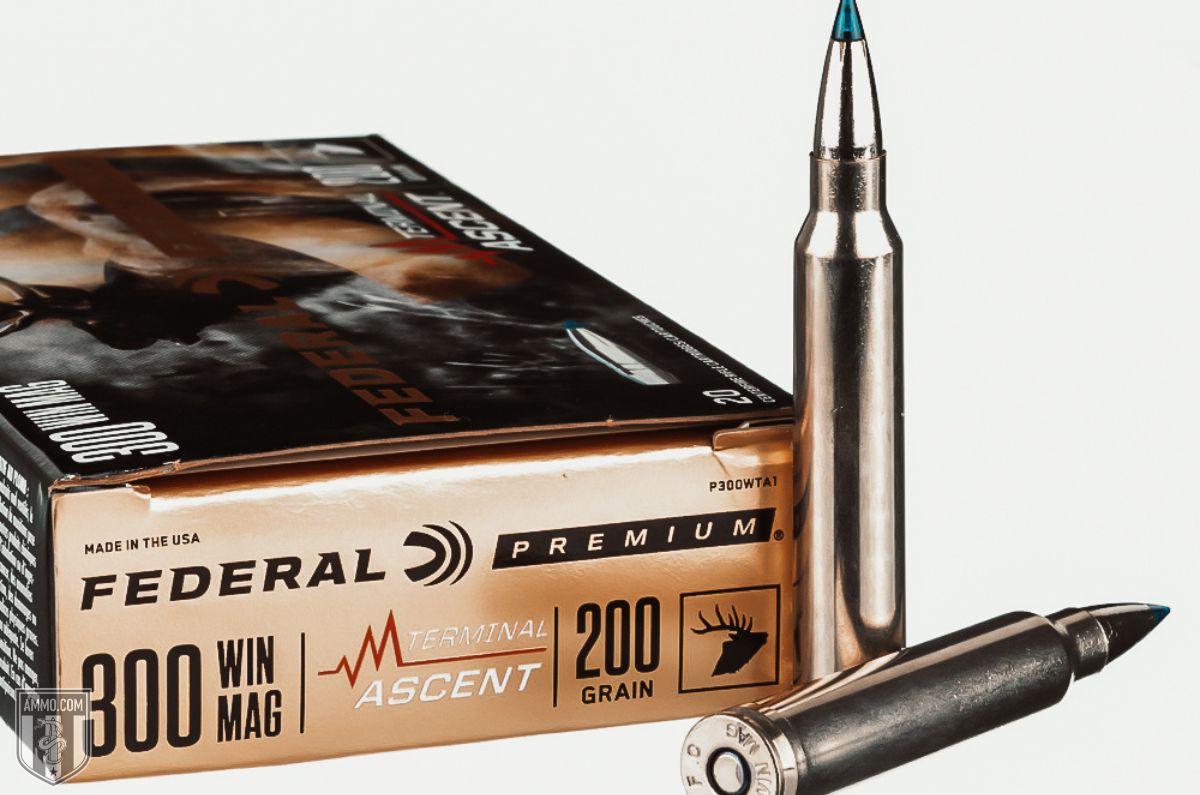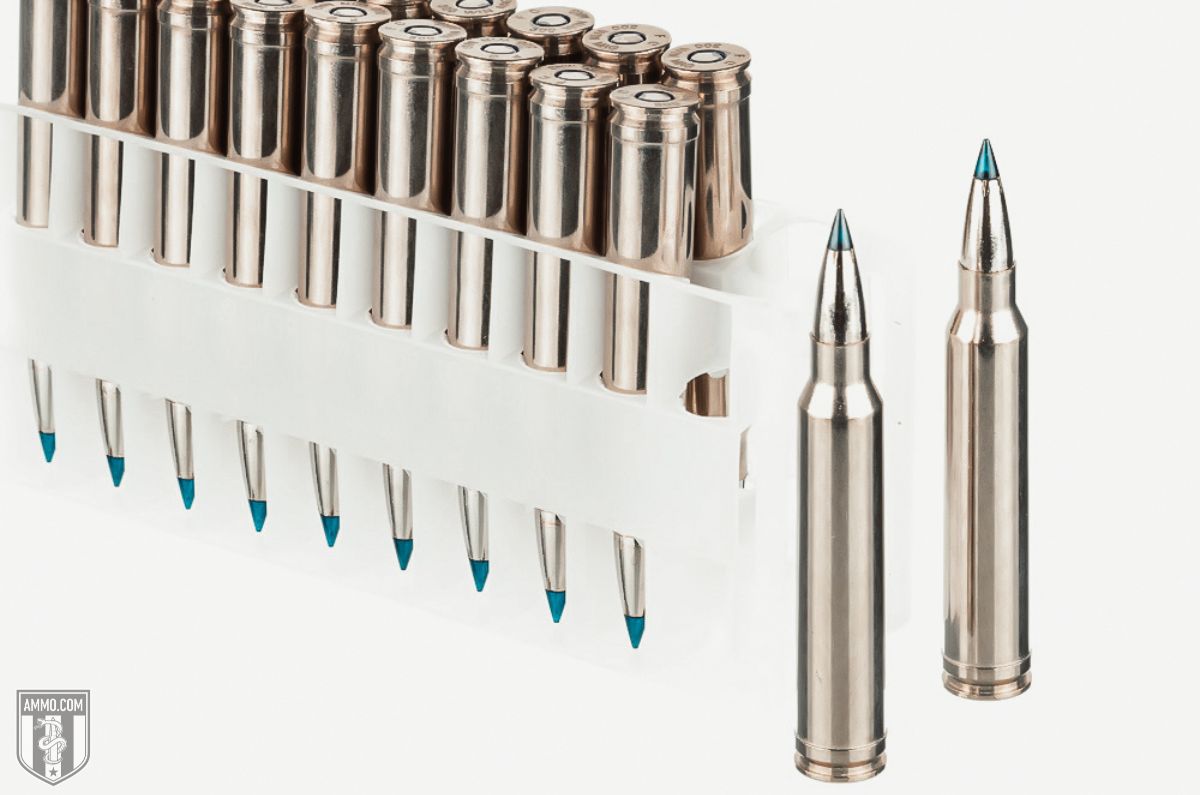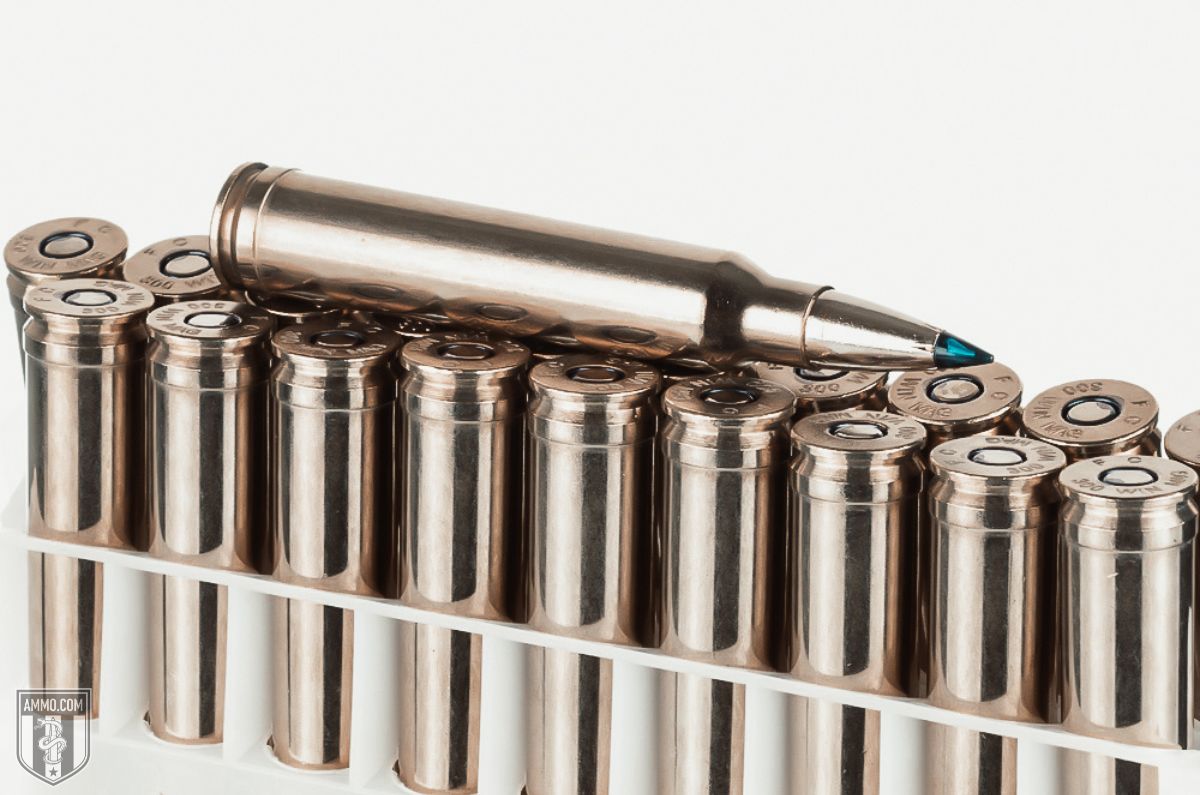28 Nosler vs 300 Win Mag: Magnum Elk Hunting Cartridges

When a new cartridge hits the market, shooters immediately start comparing it to long-standing cartridges with a proven track record. Such is the case for the 28 Nosler, as it was touted the most powerful 7mm big game hunting cartridge on the market in 2015.
When it comes to classic hunting rounds, there is none more ubiquitous than the 300 Winchester Magnum. As one of the top big game hunting cartridges in North America, the 300 Win Mag is one of those rounds that all others are compared to as it reliably takes down elk, mule deer, whitetail, and antelope every hunting season.
The 28 Nosler and 300 Win Mag are two extremely powerful centerfire rifle cartridges that are more similar than they are different. 28 Nosler ballistics are slightly superior to 300 Win Mag ballistics, but does this mean you need to upgrade your hunting rifle to the newer round?
In this article, we will evaluate the 300 Win Mag vs 28 Nosler to help you understand the differences between the two and give you a clearer idea of which cartridge is best for your shooting needs.
What is the difference between 300 Win Mag and 28 Nosler?
The main difference between the 300 Winchester Magnum and the 28 Nosler is the bullet size each rifle cartridge fires. The 300 Win Mag generally fires heavier bullets that have a diameter of 0.308” while the 28 Nosler fires slightly lighter 0.284” diameter bullets.
Cartridge Specs
When evaluating centerfire cartridges, it’s a good idea to analyze the cartridge specs to gain more knowledge of each.
Both cartridges draw their heritage from rounds designed to hunt large or dangerous game. Winchester developed the 300 Win Mag from the legendary 375 H&H Magnum cartridge while the 28 Nosler comes from the 404 Jeffery.
The 404 Jeffery sired the majority of Nosler’s cartridge line, namely the 30 Nosler, 26 Nosler, and 33 Nosler as well as other cartridges like the 7mm Remington Ultra Magnum (7mm RUM). Similarly, the 375 H&H Mag sired all of Winchester’s belted magnum cases, namely the 264, 338, and 458 Winchester Magnums as well as the 7mm Rem Mag.
One of the most prominent differences between the two is that the 28 Nosler fires a bullet diameter of 7.2mm or 0.284” while the 300 Win Mag fires the more common 30-caliber or 0.308” diameter bullets. The 300 WM typically fires bullets between 150 and 220 grains while the 28 Nosler fires bullet weights between 160 and 185 grains.
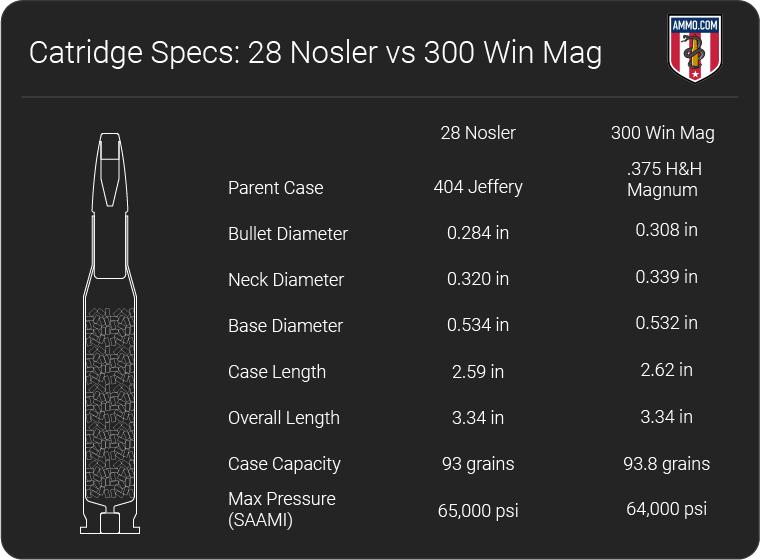
One major difference between the 300 WM and the 28 Nosler is their case design. The 300 Win Mag utilizes a belted case while the 28 Nosler is beltless.
The belt on a 300 Win Mag is superfluous as the cartridge does not generate high enough pressures that would facilitate the use of a belted case. However, Winchester left the belt on the cartridge case in a bit of creative marketing to harken back to its parent case.
One difference between these two cartridges is how each headspaces in the chamber. Due to its design, the 300 Win Mag will headspace off the cartridge belt while the 28 Nosler will headspace off the case mouth.
In terms of case dimensions, the 300 Win Mag and 28 Nosler are surprisingly similar. Their overall length is identical while their case length is separated by a mere 0.03” (the 300 WM is longer). This means that both cartridges will fit into a long action rifle, which is lighter and has a shorter bolt throw than a magnum action.
Both cartridges have almost the same case capacity, with the 300 WM having slightly higher capacity at 93.8 gr compared to 93 gr for the 28 Nosler.
One difference in case dimensions is that the shoulder angle on the 28 Nosler is slightly sharper at 35° compared to the shallower 25° shoulder angle of the 300 WM.
Finally, the max chamber pressure for the 28 Nosler is 65,000 psi compared to 64,000 psi for the 300 Win Mag per SAAMI specs.
Recoil
Recoil is an important consideration when purchasing a new rifle as a round with heavy recoil will be more difficult to control and will slow your rate of follow up shots. The potential for flinching is also an issue for cartridges with heavy recoil.
Free Recoil is affected primarily by muzzle velocity (FPS), powder charge, bullet weight, and firearm weight.
The rounds selected for the free recoil comparison are the 175 gr Accubond Long Range traveling at 3,125 fps for 28 Nosler and the Hornady 180 gr CX polymer tipped bullet with a muzzle velocity of 2,960 fps for 300 Win Mag.
The hunting rifle selected for this comparison will be the Savage 110 High Country, as this is a popular bolt-action rifle for elk hunting and is offered in both cartridges for a true “apples to apples” comparison. The average weight for Savage 110 is 8.5 pounds.
Given these criteria, the 28 Nosler will have a free recoil of 34 ft-lbs while the 300 Winchester Magnum will have 29 ft-lbs of free recoil.
Although the case capacity is nearly identical for both cartridges, 300 Win Mag loads tend to be slightly softer shooting from the factory, whereas the Nosler rounds are pushing the envelope in terms of velocity.
The higher powder charges used for the 28 Nosler means that the 300 Win Mag will generally have less recoil. Even a heavier bullet fired from the 300 WM like a 200 gr Nosler Partition at 2,750 fps will only have 31 ft-lbs of free recoil.
It should be noted that both cartridges have heavy recoil, as anything over 20 ft-lbs is considered uncomfortable for some shooters. Many hunters will opt for a muzzle brake to help mitigate the felt recoil of both cartridges and some hunting rifles come with them installed directly from the factory.
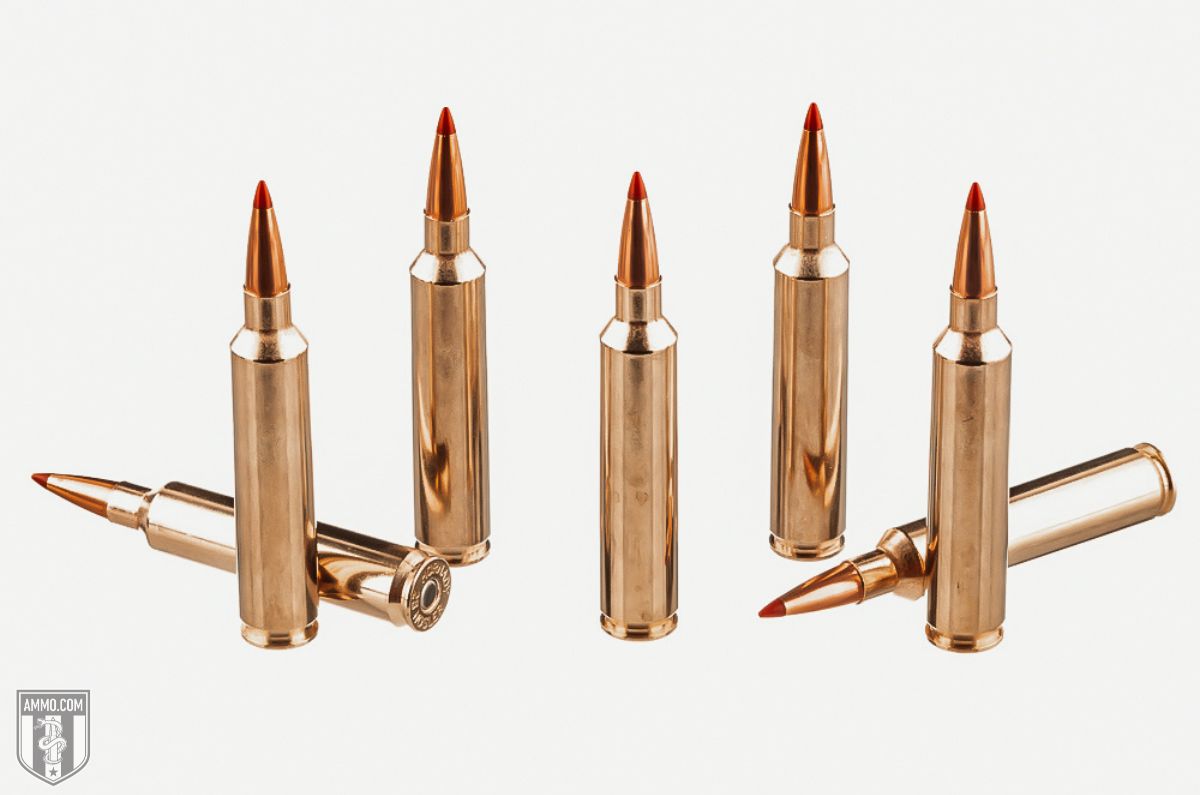
Regardless, the 300 Win Mag will generally have less recoil than the 28 Nosler, making the 300 WM the better option for recoil sensitive shooters or those prone to flinching due to recoil anticipation.
Muzzle Velocity, Kinetic Energy, and Trajectory
If you frequent any shooting or hunting forums, you are likely aware that comparing ballistics of different factory ammo is a real thread starter. Each poster will spout off why their preferred round is superior to all others based on evidence that is anecdotal at best.
This can create a lot of confusion among new shooters, so let’s take four of the most popular factory loads on the market and see how they stack up against each other!
For this comparison, we will analyze two popular options for each cartridge. For 28 Nosler, the 160 gr Ballistic Tip and 175 grain Accubond Long Range loads from Nosler were selected while the Barnes Vor-TX 165 gr TTSX and Hornady Precision Hunter 200 gr ELD-X were selected for 300 Win Mag.
As both the 300 Win Mag and 28 Nosler can shoot longer ranges, one data point for 800 yards was included in the ballistics table.
When looking at ballistics for factory ammo, it’s important to note what barrel length was used. Some manufacturers like to use a longer barrel to slightly “pad” their numbers to make their round look better.
Typical, test barrel lengths measure around 24-26”. Keep this in mind if your hunting rifle has a shorter barrel, as you might not be able to achieve the advertised muzzle velocities.

When comparing all four factory loads, both 28 Nosler rounds were slightly faster at all ranges. The 160 grain bullet for the 28 Nosler had the highest muzzle velocity at 3,200 fps while the 200 gr Hornady ELD-X for 300 Win Mag was the slowest at 2,850 fps.
The higher muzzle velocities of the 28 Nosler rounds aided them in having a flatter trajectory.
Although all four rounds were essentially identical out to 300 yards, the 28 Nosler started to shine once it hit 400 yards and beyond. At 800 yards, the difference becomes extremely apparent as the 175 gr Accubond LR bullet of the 28 Nosler had the flattest trajectory with only -127.7” of bullet drop, followed by the 160 grain Ballistic Tip with -132.8” of bullet drop.
Do not make the mistake of thinking that the 300 Win Mag has an arching trajectory, as the 300 WM has a flatter trajectory than the 6.5 Creedmoor. However, the 28 Nosler is simply a flatter shooting cartridge.
For muzzle energy, both the 300 Win Mag and 28 Nosler are extremely close. The 175 gr Accubond LR bullet for the 28 Nosler had the highest kinetic energy at 3,794 ft-lbs of force at the muzzle while the 165 gr TTSX for the 300 WM had the lowest at 3,566 ft-lbs.
An interesting data point to note is that the 200 gr ELD-X bullet for the 300 Win Mag had more kinetic energy at 800 yards (1,364 ft-lbs) than the 165 gr TTSX (965 ft-lbs) as well as the 28 Nosler’s 160 gr Ballistic Tip (1,241 ft-lbs). Only the 175 gr Accubond had more kinetic energy at 800 yards with 1,597 ft-lbs.
Barrel Life
The 300 Winchester Magnum will generally have a longer barrel life than the 28 Nosler.
When a cartridge is fired, the powder charge is ignited to push the bullet down the barrel. The resulting flame touches not only the base of the bullet, but the rifling as well. Particularly vulnerable is the rifling at the mouth of the chamber.
Heat is the enemy of barrel life, the hotter you get your barrel the faster the rifling will begin to wear out.
It should be noted that most hunters will not “shoot out” a barrel for multiple seasons with either cartridge. Those who report short barrel life are typically high-volume competition shooters that are shooting near maximum charge handloads to achieve as much muzzle velocity as possible.
To increase your barrel’s lifespan, it’s best to run either factory ammo or handloads below maximum charge. Furthermore, allowing the barrel to cool between strings of fire will also help extend your barrel life.
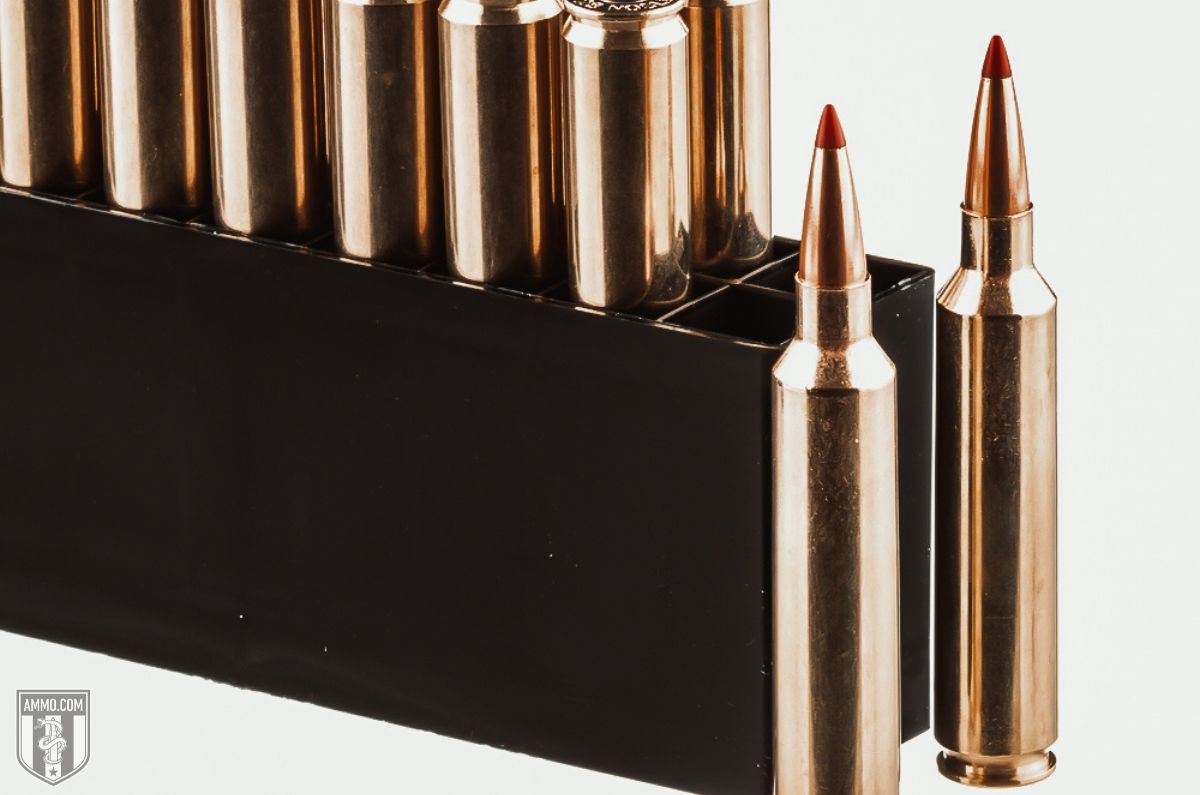
For a sub-MOA barrel, many shooters report a loss in peak accuracy for 28 Nosler around the 800-round mark, while a 300 Win Mag barrel can maintain superb accuracy between 1,000 and 1,500 rounds depending on your load.
The primary difference between the two is the 28 fires a smaller diameter bullet with a similar powder charge. This means that all the additional heat is focused on a smaller area which increases erosion of the rifling.
Handloaders can perform a technique called “chasing the lands” to help elongate the life of their barrels. As the lands of the barrel erode at the throat, a handloader can measure the levels of erosion and adjust their bullet seating depth to match it.
This helps maintain shot-to-shot consistency for a time, but it is a temporary fix as eventually they will reach the limit of how far out they can seat the bullet in the case.
The bottom line is that most hunters should not experience any appreciable difference in accuracy for multiple seasons, but if a high-volume shooter or hunter is concerned about barrel life then a 300 WM barrel will typically last longer.
Ballistic Coefficient and Sectional Density
Ballistic coefficient (BC) is a measure of how aerodynamic a bullet is and how well it will resist wind drift. Sectional density (SD) is a way to evaluate the penetration ability of a bullet based on its external dimensions, design, and weight.
One of the major benefits of 7mm bullets is there incredibly high ballistic coefficients. The design of the 7mm allows them to be incredibly sleek, streamlined, and aerodynamic which helps fight wind drift for longer range shots.
Of the bullets evaluated previously, the 7mm 175 gr Accubond Long Range has the highest BC measured at 0.648 while the 160 gr Ballistic Tip bullet measured a respectable 0.531. The 300 Win Mag options are also exceptional at bucking the wind, as the 200 gr ELD-X has a BC of 0.597 while the Barnes TTSX has the lowest BC at 0.442.
In terms of penetration and sectional density, both the 300 Win Mag and 28 Nosler are fairly close to one another and are more than adequate for large game. The 175 gr Accubond has the highest SD at 0.310 followed closely by the 200 gr ELD-X at 0.301.
To summarize, the 28 Nosler will have slightly better resistance to wind drift and slightly deeper penetration than the 300 Winchester Magnum.
Hunting
When it comes to big game hunting, you cannot go wrong with either the 300 Win Mag or the 28 Nosler. Both rifle cartridges were built for long range precision and deliver the brutal kinetic energy that’s needed to harvest large game.
The 300 Win Mag has been the go-to cartridge for elk hunting for decades thanks to its ability to shoot heavier 190 and 200 grain bullets. However, the 28 Nosler offers hunters improved trajectories and terminal ballistics on large game animals thanks to the streamlined 7mm bullets that it fires.
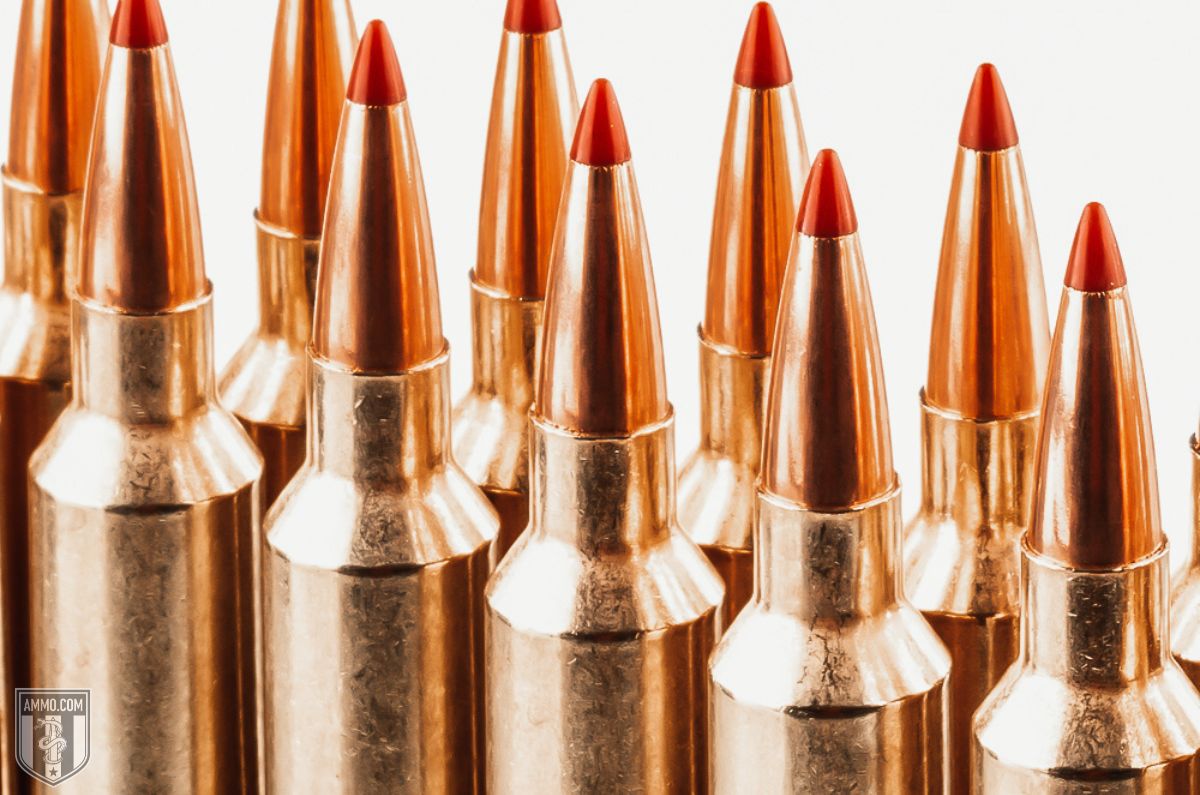
For a big game hunting rifle, you cannot go wrong with either the 300 WM or 28 Nosler.
The 300 Win Mag has been putting meat in the freezer since its release 1963 and can easily take an elk out to 600 yards. On the other hand, the 28 Nosler extends hunters’ effective range as the 175 gr Accubond LR factory load can maintain the suggested 1,500 ft-lbs of energy out to 800 yards.
For medium sized game like whitetail and antelope, both cartridges can easily take down these critters at ranges of 800 yards or more.
There is quite an ethical question of taking a shot at a game animal at longer ranges, as small miscalculations can result in wounding the poor beast and prolonging its suffering.
Though we will not debate the ethics of long range hunting here, our advice is that you spend ample time at the range practicing at the distances you expect to shoot. This way you can be confident in your skills and equipment well before you ever set foot into the woods.
Ammo and Rifle Cost/Availability
The 300 Win Mag cannot be beat when it comes to ammo availability and rifle options as it has been on the market for over half a century.
The popularity of the 300 Win Mag and ammo availability cannot be understated, as there is no worse feeling then going out to the range and not having ammo available to shoot with.
The 300 Win Mag offers shooters an extreme amount of versatility, as there are lighter loads for deer and general target shooting, while heavier loads are available for elk hunting and long range precision shooting.
Virtually every ammo manufacture like Hornady, Winchester, Remington, Barnes, Federal and Browning has some version of 300 Win Mag hunting ammo available. On the other hand, the 28 Nosler currently only has factory ammo available from Nosler, Hornady, and Browning.
In terms of cost, 300 Win Mag ammo will generally be less expensive with basic soft point ammo going for around $2/round and premium hunting ammo costing between $3-5/round.
In contrast, the 28 Nosler is more expensive to shoot as the least expensive ammo from Nosler runs around $3/round. Hornady and Browning factory loads for 28 Nosler typically run around $4/round while the premium long range ammo from Nosler will punch holes in your wallet to the tune of $6/round.
When it comes to rifle options, the 300 Win Mag continues its dominance as a multitude of bolt-action rifles are available in the caliber.
Budget friendly options are also available for 300 WM with rifles like the Remington 700 ADL or SPS, the Savage 110 Hunter, and CZ 600 Alpha all being available for under $1,000 at current market prices. If your budge it a little more flexible, the Weatherby Vanguard, Ruger Precision Rifle, and Sako S20 are all amazing options available for over $1,000.
There are also two semi-automatic options available for the 300 Win Mag in the Browning BAR and the Nemo Omen, which is an AR pattern rifle.
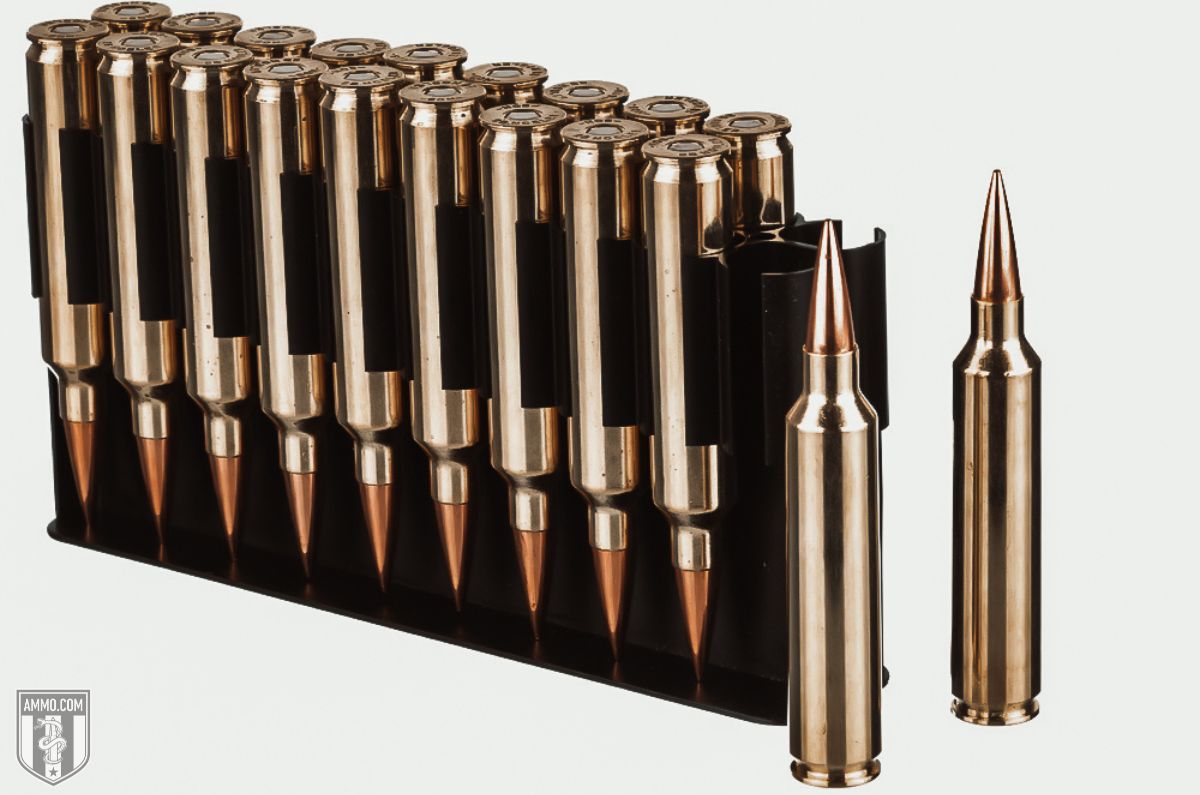
For the 28 Nosler, bolt-action rifles are your only option circa summer 2022. Savage, Bergara, Browning and Christensen are the primary manufacturers of factory rifles for the 28 Nosler, all of which will cost you over $1,000 or more.
Reloading
Reloading is one method shooters use to reduce their overall cost per round and increase the consistency of their ammo to sub-MOA levels. Furthermore, handloads can be tailored to your rifle to meet your specific shooting needs.
Handloaders have been working on the 300 Win Mag for decades, and there are numerous components and load data available for the caliber.
The 300 Win Mag fires the popular 0.308” diameter bullet, which is also used by the 308 Winchester, 30-06 Springfield, 300WSM, and 300 PRC. This makes finding inexpensive plinking bullets as well as premium hunting bullets a relatively simple task.
On the other hand, the 7mm bullet is not as common as the American classic 30-caliber. However, cartridges like the 7mm Rem Mag, 7x57 Mauser, and 7mm-08 all fire the same bullets so there are options available.
Sourcing brass will be more difficult for the 28 Nosler as it is a newer cartridge. Nosler and Hornady are the primary suppliers of new, unprimed 28 Nosler brass while 300 Win Mag cases are readily available from virtually every manufacturer that offers factory new brass.
Final Shots: 300 Win Mag vs 28 Nosler
The 300 Win Mag and 28 Nosler are two centerfire rifle cartridges that are more alike than they are different.
The 28 Nosler is a relatively new addition to the shooting community following in the footsteps of its predecessor, the 26 Nosler. The 28 Nosler offers big game hunters a new cartridge with improved downrange ballistics and a flat trajectory at the cost of relatively short barrel life.
The 300 Winchester Magnum is a classic hunting cartridge that has putting deer and elk in the freezer since the 1960’s. A favorite of big game hunters, the 300 Win Mag is also favored by long range precision rifle shooters who regularly take the cartridge to 1,000 yards and beyond.
Although 28 Nosler ballistics are superior to those of the 300 Win Mag, most shooters will opt for the tried-and-true 300 primarily due to ammo availability. Finding 28 Nosler ammo can be a task, which is not ideal for casual shooters or hunters who have no intention of shooting past 500 yards.
However, if you are a competitive shooter who needs to squeeze every fps out of a cartridge or enjoy having the best ballistics possible for your hunting rifle, then the 28 Nosler deserves a look.
No matter which cartridge you choose, make sure you stock up on ammunition here at Ammo.com and I’ll see you on the range!
Ammo Comparisons
- .308 vs 5.56
- 6.5 Creedmoor vs .308
- .300 Blackout vs .308
- .300 Win Mag vs .308
- .243 vs .308
- .308 vs .30-06
- 7mm-08 vs .308
- .270 vs .308
- 7.62x39 vs .308
- .223 vs .308
- .338 Lapua vs .308
- .380 ACP vs 9mm
- .223 vs 5.56
- .300 Blackout vs 5.56
- 9mm vs 45 ACP
- 9mm vs 40 S&W
- .357 SIG vs 9mm
- 10mm vs 9mm
- 9mm vs 9mm Luger
- .243 vs .270
- .300 Win Mag vs .30-06
- .270 vs .30-06
- .40 vs .45
- 38 Special vs 357
- 9mm vs 40 vs 45
- 5.56 vs 7.62x39
- 338 Lapua vs .30-06
- .30-30 vs .30-06
- 300 PRC vs 338 Lapua
- .30-06 vs 7mm
- 300 Win Mag vs 338 Lapua
- 300 PRC vs 300 Win Mag
- 300 WSM vs 300 Win Mag
- 338 Win Mag vs 338 Lapua
- 12 Gauge vs 20 Gauge
- 10mm vs 357 Mag
- .30-30 vs 7.62x39
- 224 Valkyrie vs 22-250
- 17 HMR vs 22 Mag
- 7.62x39 vs .300 Blackout
- 45 ACP vs 45 Auto
- 45-70 vs 30-30
- 300 Blackout vs 223
- 357 Magnum vs 9mm
- 350 Legend vs 300 Blackout
- 224 Valkyrie vs 223
- 45 ACP vs 38 Super
- 6.5 Grendel vs .308
- 17 HMR vs 22 LR
- 10 Gauge vs 12 Gauge
- 22-250 vs 223
- 45 Colt vs 45 ACP
- 350 Legend vs 30-30
- 5.7x28 vs 223
- 5.7 vs 9mm
- 5.56 vs 5.7
- 22 vs 9mm
- Buckshot vs Birdshot
- 450 Bushmaster vs 308
- 450 Bushmaster vs 223
- Buckshot vs Slug
- 6.5 Grendel vs 5.56 vs 223
- 6mm ARC vs 6.5 Grendel
- 44 vs 45
- 458 SOCOM vs 5.56
- 357 vs 44
- 32 ACP vs 380
- 300 Win Mag vs 338 Win Mag vs 338 Lapua Mag
- 450 Bushmaster vs 458 SOCOM vs 50 Beowulf
- 6mm Creedmoor vs 6.5 Creedmoor
- TMJ vs FMJ
- 44 Special Vs 44 Magnum
- 45 90 vs 45 70
- 6.8 Western vs 6.8 SPC
- 50 Beowulf vs 50 BMG
- 26 Nosler vs 6.5 PRC
- 28 Gauge vs 410
- 6.8 SPC vs 5.56
- 6.8 SPC vs 6.5 Grendel
- 6.8 Western vs 7mm Rem Mag vs .28 Nosler
- 6.8 Western vs 6.5 Creedmoor
- 22 Hornet vs 223
- 6.8 Western vs 6.5 PRC
- .410 vs 12 Gauge
- .410 vs 20 Gauge
- 22 LR vs 22 Mag
- 6mm ARC vs 243
- 7mm-08 vs 270
- 243 vs 6.5 Creedmoor
- Nickel vs Brass Casing
- 204 Ruger vs 223
- 50 Beowulf vs 5.56
- 260 Remington vs 6.5 Creedmoor
- 6mm Remington vs 243
- 28 Nosler vs 300 PRC
- 50 Beowulf vs 50 AE
- 22 Nosler vs 22-250
- 450 Marlin vs 45-70
- 300 Win Mag vs 300 Norma
- 458 SOCOM vs 300 Blackout
- 38-55 vs 45-70
- 22 Hornet vs 22 LR
- 300 Norma vs 338 Lapua
- 338 Lapua vs 50 BMG
- 28 Nosler vs 300 Win Mag
- 28 Nosler vs 6.5 Creedmoor
- 204 vs 22-250
- 458 SOCOM vs 45 70
- 44 40 vs 45 70
- 6.8 SPC vs 6.5 Creedmoor
- 450 Bushmaster vs 30-06
- 7mm Rem Mag vs 300 Win Mag
- 30 Carbine vs 223
- 25-06 vs 30-06
- 26 Nosler vs 28 Nosler
- 16ga vs 12ga
- 30 06 vs 7.62 x54R
- 9mm Makarov vs 9mm Luger
- 350 Legend vs 223
- 30 Carbine vs 5.56
- 6.5x55 vs 6.5 Creedmoor
- 6.5 Creedmoor vs 270 vs 25-06
- M193 vs M855
- 450 Bushmaster vs 458 SOCOM
- 6.5 Grendel vs 6.5 Creedmoor
- 350 Legend vs 5.56
- .277 Fury vs 6.8 SPC
- 277 Fury vs 300 Win Mag
- 10mm vs .45 ACP
- 277 Fury vs 223
- 6.8 SPC vs 300 Blackout
- 6.5 PRC vs 6.5 Creedmoor
- 277 Fury vs 308
- 277 Fury vs 6.5 Creedmoor
- 350 Legend vs 450 Bushmaster
- 277 Fury Vs 5.56 NATO
- 10mm vs 40S&W
- 32 ACP vs 9mm
- 32 Special vs 9mm
- 8.6 Blackout vs 300 Blackout
- 30 Super Carry vs. 9mm
- 5.56 vs 9mm
- .50 Action Express vs 9mm
- 7.62x25 vs. 9mm
- 10mm vs 44 Magnum
- 300 Blackout vs 300 Win Mag
- 6.5 Grendel vs 300 Blackout
- 460 Rowland vs 10mm
- 300 RUM vs 300 PRC
- 300 Norma vs 300 PRC
- 45 GAP vs 45 ACP
- 7mm PRC vs 300 Win Mag
- 300 PRC vs 6.5 Creedmoor
- 300 PRC vs 308
- 357 SIG vs 357 Mag
- 7.62x39 vs 7.62x51
- 243 Win vs 223 Rem
